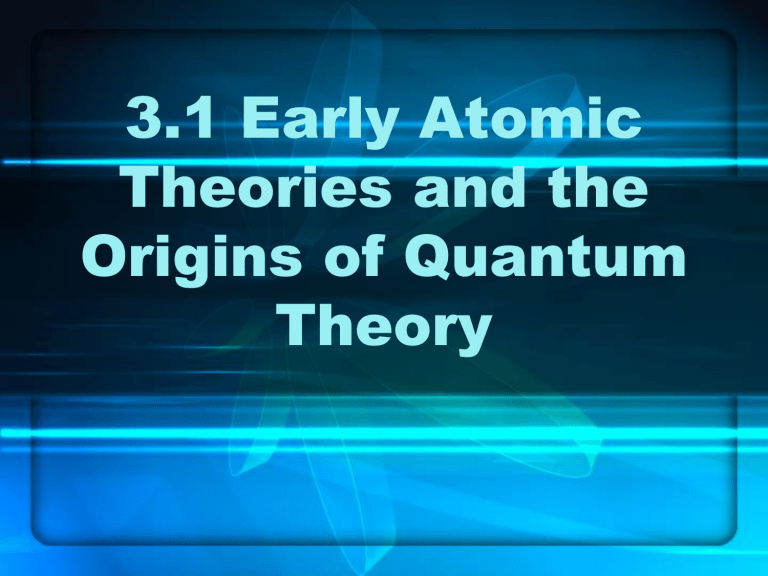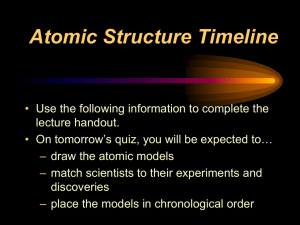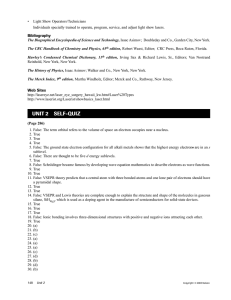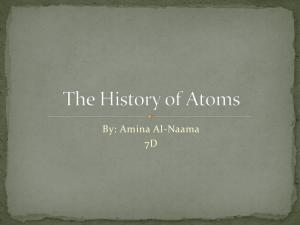3.1 Early Atomic Theories and the Origins of Quantum Theory
advertisement

3.1 Early Atomic Theories and the Origins of Quantum Theory Democritus Aristotle Ancient Philosophy • • • • Who: Aristotle, Democritus When: More than 2000 years ago Where: Greece What: Aristotle believed in 4 elements: Earth, Air, Fire, and Water. Democritus believed that matter was made of small particles he named “atoms”. They debated in public forums in front of a crowd. Aristotle was much more charismatic and forceful and won the arguments. Alchemists • • • • Who: European Scientists When: 800 – 900 years ago Where: Europe What: Their work developed into what is now modern chemistry. • Why: Trying to change ordinary materials into gold. Lead to the concept of change…lead to the development of glassware like Erlenmeyer flasks, beakers… Alchemic Symbols • Proust is responsible for the law of definite proportions. It states that the elements combined to form compounds in certain welldefined proportions, rather than mixing in just any proportion. Lavoisier (husband and wife team) proposed the Law of conservation of mass. Matter is never created or destroyed in a chemical reaction John Dalton Particle Theory • • • • Who: John Dalton (high school teacher) When: 1808 Where: England What: Described atoms as tiny particles that could not be divided. Thought each element was made of its own kind of atom. Basic ideas of his theory are still correct. Is credited with the law of multiple proportions. • If two elements form more than one compound between them, then the ratios of the masses of the second element which combine with a fixed mass of the first element will be ratios of small whole numbers J. J. Thompson Discovery of Electrons • • • • Who: J. J. Thompson When: 1897 Where: England What: Thompson discovered that electrons were smaller particles of an atom and were negatively charged. • Why: Thompson knew atoms were neutrally charged, but couldn’t find the positive particle. Used cathode ray tubes for his experiments. Cathode rays tubes J.J. Thomson studied was the conduction of electricity through gases. One subject which interested Thomson was cathode rays. These rays are emitted at the cathode, or negative terminal, in a discharge tube. I The nature of the cathode rays was controversial. Although Thomson thought the rays must be particles, many Europeans thought they were an 'etherial disturbance', like light. In Germany Hertz had observed the rays passing through thin sheets of gold. It seemed impossible that particles could pass through solid matter. Cathode rays being deflected by a magnetic field, whose direction is into the paper. The magnetic field produces a force which deflects the cathode rays. In his tube, Thomson positioned the coils so that the deflection was in the opposite direction to the deflection produced by the electric field. By adjusting the strengths of the fields the rays could be deflected, in one direction by the electric field, and back an equal amount by the magnetic field. The forces were balanced. Ernest Rutherford Atomic Structure I • • • • Who: Ernest Rutherford When: 1911 Where: England What: Conducted an experiment to isolate the positive particles in an atom. Decided that the atoms were mostly empty space, but had a dense central core. • Why: He knew that atoms had positive and negative particles, but could not decide how they were arranged. Gold foil experiment He fired Alpha particles at an extremely thin gold foil. • He expected them to go straight through with perhaps a minor deflection. • Most did go straight through, but to his surprise some particles bounced directly off the gold sheet! • • What did this mean? • • Rutherford hypothesized that the positive alpha particles had hit a concentrated mass of positive particles, which he termed the nucleus. Rutherford’s Lab at McGill Atomic Structure II • • • • Who: Niels Bohr When: 1913 Where: England What: Proposed that electrons traveled in fixed paths around the nucleus. Scientists still use the Bohr model to show the number of electrons in each orbit around the nucleus. • Why: Bohr was trying to show why the negative electrons were not sucked into the nucleus of the atom.(which are +) Electron Cloud Model • Electrons travel around the nucleus in random orbits. • Scientists cannot predict where they will be at any given moment. • Electrons travel so fast, they appear to form a “cloud” around the nucleus. Electron Cloud Model • Neil’s Bohr Experiment… • Studied light emitted from a heated source after it is seperated by a prism. • Light is SPECIFIC and has specfic energy (colour)…a full rainbow is never seen. Thus electrons have specific energy…”orbit” is defined • Based on work by Planck – light is emitted in discreet quanta Neils Bohr • Rays or Particles? Marie Curie • Curie-Joliots in Paris, had bombarded beryllium with alpha-particles, and found that very penetrating gamma rays were emitted. Cockcroft and Walton thought that similar rays should be observed when they bombarded light elements with protons. • Unfortunately, the Curie-Joliots were mistaken in identifying the 'radiation'. In January 1932 James Chadwick repeated their experiments and found that the reaction produced neutral particles, neutrons, that Rutherford had predicted in 1920. A few months after Chadwick's discovery Rutherford came to Cockcroft and Walton and told them they 'ought to put in a fluorescent screen and get on with the job'. Rutherford was clearly hoping to see alpha-particles, and a fluorescent screen would be the best way to detect them. • Led to the idea that the nucleus is BREAKABLE…new atoms can be created!!! Led to the development of the nuclear bomb with uranium (“little boy”) On 14 April 1932 Walton set up the tube and bombarded lithium with high energy protons. He then crawled into the little observation cabin set up under the apparatus and immediately saw scintillations of the fluorescent screen. The reaction was giving off alphaparticles…which are HELIUM NUCLEI! Led to the development of the nuclear bomb with plutonium (“Fat man” 20 000 TNT) and atomic bombs with hydrogen. ( 1 million TNT)




